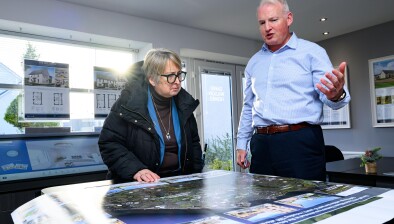Edinburgh World Heritage takes on its first post-war building to address chronic energy efficiency and conservation issues
Edinburgh World Heritage has announced the launch of an innovative new project to improve the energy efficiency of the Canongate Housing development, alongside undertaking vital conservation work on the architecturally important listed buildings.
The Category B-listed development by Sir Basil Spence was completed in 1969 and consists of three blocks of flats comprising 30 dwellings, occupying a critical and historically sensitive location in Edinburgh’s Old Town. Sir Basil Spence was one of Scotland’s most accomplished and prolific 20th-century architects with a portfolio including Coventry Cathedral and the British Embassy in Rome.
Despite being listed for its architectural qualities, there is an opportunity to upgrade the Canongate housing complex to meet modern environmental standards. Doing so will reduce the high cost of heating apartments, and ensure the building is wind and watertight.
Through the project, Edinburgh World Heritage hope to demonstrate how the core principles of conservation and sustainability are aligned. Research conducted by the charity in 2016 found that a poorly maintained building can result in higher fuel bills – up to 15% higher in some cases. This in turn increases the building’s carbon footprint.
This project is being funded by the Scottish Government through Scotland’s Energy Efficiency Programme (SEEP) and carried out in partnership with the City of Edinburgh Council. SEEP aims to encourage local authorities to find innovative ways to reduce emissions and tackle fuel poverty.
Adam Wilkinson, director of Edinburgh World Heritage, said: “We believe that sustainability and conservation work hand-in-hand, and so the opportunity to combine these fields and make improvements both to the building and to the quality of life for its residents is one we’re excited to explore.
“There is the potential for this project to serve as an exemplar to similar post-war buildings elsewhere.”
“The opportunity to conserve a modern building from the 1960s rather than the older 18th and 19th century buildings that dominate the World Heritage Site represents a moment for us to apply our conservation expertise in a different context.”
Paul Wheelhouse, Scottish Government Minister for Business, Energy and Innovation, said: “This project will have a positive impact on people’s lives, ensuring they have warm homes and businesses, while at the same time, through generating information on the performance of technology deployed, helping us develop strategies to address fuel poverty that can be rolled out in other buildings throughout Scotland.
“Finding the right sustainable solution for historic, listed buildings such as this will be invaluable to implementation of the national SEEP programme as a whole.
“This is one of a number of pilots being taken forward across Scotland, under the SEEP programme, that will help to identify optimal solutions for different building types and locations, which will then allow us to best direct investment to the right places to ensure we not only grow our renewable heat capabilities, but also fulfil our commitments to tackle fuel poverty.”
Councillor Lesley Macinnes, Edinburgh Council’s transport and environment convener, added: “Energy efficiency in buildings and the development of heat strategies are important priorities for us to help alleviate fuel poverty, develop wider job opportunities as well as reducing carbon emissions. We’re delighted to be in partnership with Edinburgh World Heritage on the second phase of the Scottish Energy Efficiency Programme which aims to deliver more energy efficient homes and buildings.
“As well as meeting key Council objectives and targets, conserving these post war buildings in this historic part of the city will bring great benefits to residents and businesses as their fuel costs are reduced and their homes are significantly improved. As well as helping to alleviate fuel poverty, projects like this also help to create local jobs and more sustainable communities.”
















